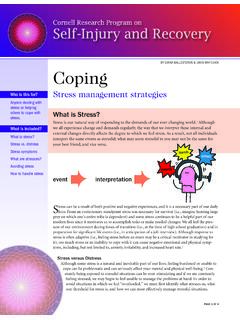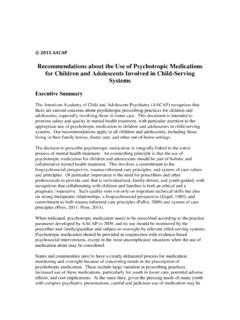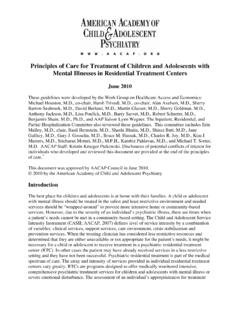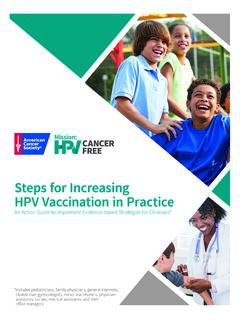Transcription of Adolescent Non-Suicidal Self-Injury (NSSI) Interventions
1 Adolescent Non-Suicidal Self-Injury (NSSI) InterventionsAriel Henrie Gonzales, P/MHNP, MSN, and Linda Bergstrom, RN, CNM, PhD, FACNMA riel Henrie Gonzales, P/MHNP, MSN, is an alumnus, University of Utah, Salt Lake City, Utah, USA. Linda Bergstrom, RN, CNM, PhD, FACNM, isAssociate Professor (Clinical), College of Nursing, University of Utah, Salt Lake City, Utah, USAS earch terms: Adolescent , deliberate self -harm, intervention,parasuicide, self -injurious behavior, self -mutilation, self -wounding, therapy,treatmentAuthor with a copy tothe Editor: :Evidence-basedtreatmentofnon-suicidalse lf- injury (NSSI) :To review the evidence base supporting current Interventions for USED:PubMed searches and ancestry.
2 All treatments studied developmental group therapy, indi-vidual cognitive-behavioral therapy, and dialectical behavioral therapy foradolescents were found to be comparable to the typical treatments offered in thetreatment settings where the research was conducted. Additional strategies such asharm reduction have very limited evidence suggesting they may be helpful. A fewcommon Interventions including relaxation techniques have extremely limited evi-dence suggesting they may be perceived as harmful by Self-Injury (NSSI), the deliberate destruction ofone s body tissues for nonsocially sanctioned reasons but notas a suicide attempt (Klonsky & Muehlenkamp, 2007), is aconcerning, repetitive behavior typically beginning betweenages 14 and 24 (Nixon, Cloutier, & Jansson, 2008).
3 Incidenceis high in adolescents and higher in adolescents with mentalillness. No NSSI treatment or intervention has been exten-sively studied in adolescents. The authors will review theexisting literature on the treatment of NSSI in adolescents,both identifying current treatments and Interventions andreviewing the existing literature studying those treatmentsand and TheoryNock and Prinstein (2004) found that 82% of adolescentswith a history of inpatient treatment reported a history ofNSSI. Lloyd-Richardson, Perrine, Dierker, and Kelley (2007)identified that of a convenience sample of students ingrades 9 12 reported they had engaged in NSSI in the lastyear.
4 This incidence is similar to estimates in previous was not influenced by sex, age, socioeconomicstatus, or living situation. Their NSSI included cutting,burning, scraping, and self -tattooing. Most patients withNSSI have multiple reasons for engaging in this behavior(Lloyd-Richardson et al., 2007; Prinstein, 2008). The mostcommonly reported reason for NSSI (41%) was to feel any-thing at all, even pain. Other reasons reported at levels at orabove 33% were to try to get a reaction from someone, even ifit is negative, to stop bad feelings, to get control of the situ-ation, to give yourself something to do when alone, to getattention, and to relieve feeling numb or empty, showingthat adolescents report two main reasons for NSSI: social andemotional (Lloyd-Richardson et al.)
5 , 2007, p. 1189).Though not all individuals who engage in NSSI meet cri-teria for a mental disorder, NSSI is predictive of a psychiat-ric diagnosis (Klonsky & Muehlenkamp, 2007). NSSI is adiagnostic criterion for borderline personality disorder(BPD) ( american Psychological Association, 2000) and isalso suggestive of bipolar I disorder (Joyce, Light, Rowe,Cloninger, & Kennedy, 2010). Clients with anxiety, depres-sion, an eating disorder, or substance abuse are at increasedrisk of NSSI (Klonsky & Muehlenkamp, 2007).
6 Clients whopresent with NSSI are more likely to have particular person-ality characteristics including harm avoidance (Joyce et al.,2010, p. 253), negative emotionality .. deficits in emotionskills .. [and] self derogation (Klonsky & Muehlenkamp,2007, p. 1047 8), and neuroticism and openness to experi-ence (Brown, 2009, p. 30). These deep-seated traits maycontribute to initial or chronic NSSI and may in some casesresult from attachment disorders or childhood abuse. NSSI functions as an emotional regulation strategy and is there-fore secondary to a condition in which the client lacks theknowledge, willingness, or ability to regulate emotions, par-ticularly intense emotions, in a socially acceptable andhealthy way (Hall & Place, 2010).
7 It has been found to corre-late with emotional dysregulation in female young adults(Gratz & Roemer, 2008).bs_bs_bannerJournal of child and Adolescent Psychiatric Nursing issn 1073-6077124 Journal of child and Adolescent Psychiatric Nursing26(2013) 124 130 2013 Wiley Periodicals, causative factors for this dysregulation have beenexplained theoretically. Wallin (2007) wrote that emotionalregulation ability is often a function of childhood experience,particularly caregiver attachment. Problematic attachment,childhood abuse, and other pathology can predispose someclients to states of high emotionality and even to dissociativestates.
8 These clients may engage in drastic behavior such asNSSI to express or regulate intense emotional states. Clientsexperiencing dissociation who feel a frightening distancefrom their own feelings may find NSSI offers relief throughcreating pain and highlighting the reality of embodiment(Wallin, 2007). Adolescents with NSSI tend toward morenegativity and emotional distance in their relationships withparents (Prinstein, 2008) which may be reflective of lifelongattachment problems in some ReviewSeveral authors have established that NSSI is a common andconcerning behavior in adolescents (Lloyd-Richardson et al.)
9 ,2007 and Nixon et al., 2008) but there are comparatively fewstudies of Interventions for NSSI. Literature searches on thistopic are complicated by the use of multiple terms to describeNSSI, including deliberate self -harm (DSH), parasuicide, self -injuriousbehavior, self -mutilation, and self -wounding, and are further complicated by the fact that someuses of each of the above terms include both NSSI and Self-Injury with suicidal intent (Mangnall & Yurkovich, 2008).Some authors have used these terms to refer to self -injuriousactions such as headbanging in severely mentally retarded orautistic individuals (Richman & Lindauer, 2006).
10 In thisarticle, NSSI indicates deliberate Self-Injury that is notintended to be fatal and is related to social or emotionalfactors as opposed to developmental was used to search the literature for the term NSSIand the above terms often used to describe NSSI behavior inany combination with the terms intervention, therapy, or treatment. Combinations returning more than 100 resultswere refined using two separate methods in order to increasethe likelihood of retaining relevant results in at least onesearch.

















